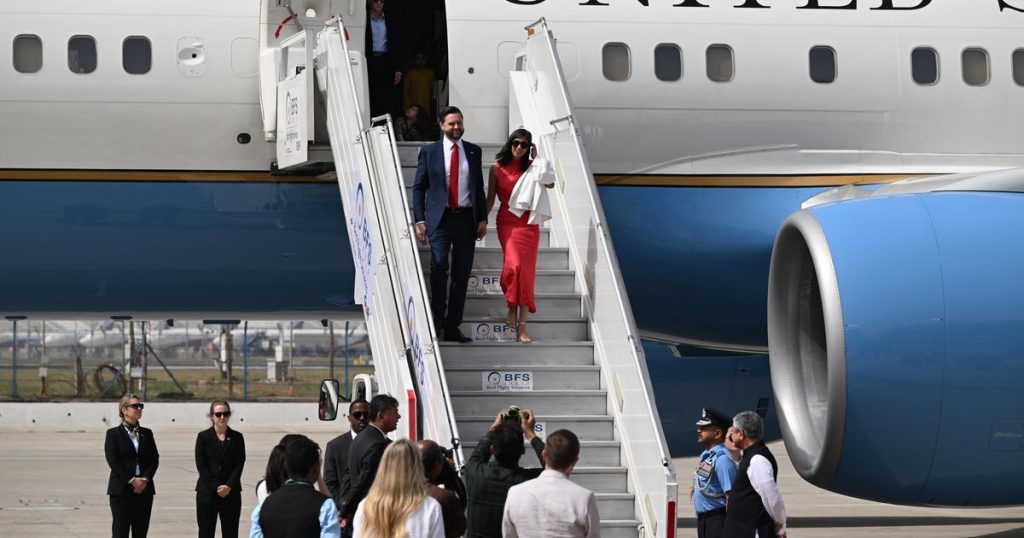U.S. Vice President JD Vance has embarked on a significant four-day visit to India, aiming to foster stronger bilateral ties and negotiate a crucial trade deal amid ongoing trade tensions. This visit is particularly pertinent as India aims to counter U.S. tariffs and establish itself further as America’s primary economic partner in the region. The vice president’s arrival coincided with the news of Pope Francis’s passing, leading to public expressions of condolence from Vance, who had met the pope just days prior.
| Article Subheadings |
|---|
| 1) Significance of the Visit |
| 2) Cultural Engagement and Personal Touch |
| 3) The Strategic Context |
| 4) The Trade Deal Imperative |
| 5) Prospects for Future Relations |
Significance of the Visit
Vice President JD Vance arrived in India with a mission that goes beyond mere diplomacy; it underscores the essential relationship between the U.S. and India at a critical juncture. The visit comes at a time when India is keen to fortify its position against rising U.S. tariffs and work collaboratively to enhance economic cooperation. As the largest trading partner for India, the role of the United States in shaping India’s trade policies cannot be overstated. This visit is a continuation of dialogue initiated between Prime Minister Narendra Modi and former President Donald Trump, ultimately reflecting the ongoing strategy to build comprehensive bilateral ties.
Cultural Engagement and Personal Touch
Upon arrival, Vance was welcomed with an Indian classical dance performance, highlighting the cultural vibrancy of the country. Accompanied by his wife, Usha Vance, and their young children, the visit is also aimed at establishing a personal connection with the Indian populace. In a significant gesture, the family visited the renowned Akshardham Temple, which is deeply imbued with spiritual and cultural significance. Usha Vance, of Indian heritage, adds a layer of cultural connectivity, offering a unique lens through which to view the bilateral discussions. Events like these not only foster goodwill but also signify an acknowledgment of India’s rich cultural landscape.
The Strategic Context
In a broader context, the U.S.-India relationship is increasingly seen as a strategic bloc against rising Chinese influence in the Indo-Pacific region. India’s inclusion in the Quadrilateral Security Dialogue, known as the Quad, which also involves Japan and Australia, reflects this shared geopolitical interest. This visit timely aligns with growing concerns over the expansionist policies of China, particularly in Asia. Mr. Trump is anticipated to attend a future summit of Quad leaders in India, further solidifying the coalition against perceived regional threats. Furthermore, Prime Minister Modi has previously established a rapport with Trump, underscoring the importance of continuance in strategic dialogue and defense collaborations, crucial not just for the two nations but for regional stability.
The Trade Deal Imperative
Negotiations for a bilateral trade deal have become a focal point of significance for both nations. India is keen on mitigating potential impacts from outlandish tariffs imposed by the U.S., including a hefty 26% levy that could directly affect several sectors, including agriculture, automotive, and healthcare. Achieving a target to double bilateral trade to $500 billion by 2030 remains a primary objective. This proposed trade framework could potentially rejuvenate sectors that are facing challenges from U.S. tariffs while also ensuring that India retains its position as a favorable trade partner. Both Vance and Modi are expected to engage in detailed discussions to facilitate trade negotiations, highlighting this visit’s economic underpinnings.
Prospects for Future Relations
Looking ahead, the future of U.S.-India relations remains promising but complex. If effectively navigated, the relationships could extend beyond economics and trade into comprehensive defense partnerships. India has signaled intentions to import more energy resources, defense equipment, and other goods from the U.S., illustrating a commitment to deepening ties. However, the ongoing rhetoric from Trump’s administration, labeling India a “tariff king,” poses challenges that must be reconciled through constructive dialogue. The need for a unified approach in addressing trade inconsistencies and fostering cooperation is critical as both nations strive for mutual growth in an increasingly competitive global landscape.
| No. | Key Points |
|---|---|
| 1 | Vice President JD Vance arrived in India to strengthen bilateral ties and explore trade negotiations. |
| 2 | The visit underscores the importance of cultural engagement, enhancing personal ties between the leaders. |
| 3 | U.S.-India relations are strategically significant, particularly in counterbalancing China’s influence in the Indo-Pacific. |
| 4 | Negotiations focus on a trade deal with a target of $500 billion in bilateral trade by 2030. |
| 5 | The future of relations may enhance defense collaborations while addressing ongoing trade challenges. |
Summary
The visit of U.S. Vice President JD Vance to India is crucial for reinforcing the growing partnership between the two nations. With trade negotiations high on the agenda, there is significant potential for bolstering economic ties and addressing mutual concerns regarding tariffs. As both countries navigate complex geopolitical landscapes, the outcomes from this visit could set a precedent for future collaborations, not only economically but also in regional security frameworks. The personal engagement observed during this visit also signifies a deeper cultural connection that may play a role in fostering enduring diplomatic relations.
Frequently Asked Questions
Question: What prompted Vice President Vance’s visit to India?
Vice President Vance’s visit aims to strengthen U.S.-India bilateral ties, negotiate a bilateral trade deal, and address concerns over U.S. tariffs.
Question: What cultural activities did the Vance family engage in during the visit?
Upon arrival, the Vance family attended an Indian classical dance performance and visited the Akshardham Temple, showcasing cultural engagement.
Question: Why is the U.S.-India trade deal significant?
The trade deal is crucial as it aims to double trade to $500 billion by 2030, helping to mitigate the impact of tariffs imposed by the U.S. on Indian goods.
